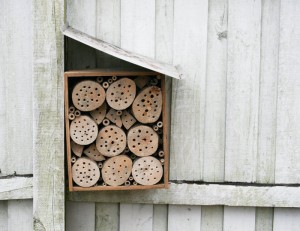Or a food forest.
Or a garden.
You may have added irrigation, planned in some nice cover crops or perhaps picked up a metric donkeyload of mulch along the way.
Things are getting ready to grow. But are you ready for the next steps? Fertilization, water, pruning, weeding are hard to “outsource,” but two other areas of gardening are easier to manage than you might think.
Which two areas? Pollination and pest control.
Let’s take a look… and then I’ll share how to make a solitary bee house that will staff your garden with lots of free laborers.
Pollination
Pollination is BIG business. Did you realize that many millions of dollars are spent moving honeybee hives around the country from field to field every year? Sometimes, the bees are imported from Australia, sent to the fields in boxes, then left to die off after their pollination work is through. That kind of extravagance (and sheer cruel wastefulness) requires big bucks.
Unfortunately, the honey bee populations across the US are in decline, hence the importing from Australia. Whether it be a build-up in toxins, the genetic modification of plants to include substances harmful to bees, the shrouding of the ancient ley lines by cellular towers or perhaps the “beeginning” of the Apocalypse, honeybees are in trouble. For years they’ve been a primary pollinator of many of our favorite crops. Without bees we wouldn’t have almonds. Or zucchini. Though I could handle losing the latter.
Thanks to the drop-off in honeybee populations, farmers and gardeners have started looking to alternate sources for pollinators.
Sometimes we tend to think of bees as basically falling into two categories: honeybees and bumblebees (people with wooden houses may also chime in “carpenter bees” at this point); however, there are many thousands of varieties of bee, many of which are excellent pollinators.
Unfortunately, we often inadvertently exclude these hard workers from our yards. Old lumber, dead trees, even stick piles and stands of weed canes left from the previous year… these are where they raise their young. Mason bees are one of the best pollinators you can attract with a bee house. (Don’t worry – I’m getting to the part where I tell you how to make a solitary bee house. Patience!)
Pest Control
Did you realize that many wasps and some bees are avid hunters of pests?
Just yesterday my wife pointed out a wasp crawling into the side of one of my hot tub ponds in the backyard. There’s a space there that used to contain piping. Now it contains a wasp nest. The reason my wife pointed out our stinging friend? It was carrying a gooey green chunk of caterpillar into its nest. All day long, wasps hunt their prey, killing untold thousands of pests. How do we thank them?

Yeah, I know. It’s not fun to be stung. And there are times where it’s prudent to remove a wasp nest. However, nesting wasps with large colonies aren’t the only caterpillar hunters in your yard. There are also solitary wasps which rarely if ever sting people. Some, like mud daubers and potter wasps, build muddy little nests under eaves and in barns, chicken coops and other outbuildings. Others will nest in holes, much like mason bees. The thing is: they stuff those holes with the insects they kill, then lay their eggs on the insect corpses. Their larva feast, then grow up, then go kill insects and lay eggs of their own. Oh yeah.
How To Make a Solitary Bee House
This isn’t rocket science, fortunately, or I wouldn’t be able to do it.
My grandfather was an amazing carpenter and boatbuilder. I am not, yet I can make a house that will attract solitary bees and wasps.
Here’s what you need to make a solitary bee house (which also attracts some solitary wasps):
1. Pieces of dry wood that are at least 6-8″ deep. Chunks of trunk, old, non-pressure treated lumber, even pieces of thick branches can be used. Pieces of bamboo are also good.
2. A selection of long drill bits and a drill. I used bits ranging from 1/4″ to 5/8″.
3. A somewhat dry/sunny place to hang it up.
(CLICK HERE to read the rest over at The Prepper Project. And don’t forget to check out my new survival gardening audio course!)



3 comments
You're to blame for getting me at least somewhat interested in gardening, well, permaculture actually. It was that Geoff Lawton video that started it. The permaculture rabbit hole is really deep. I spent days watching videos, not just the ones done by Mr. Lawton but by a few others as well.
One tidbit I picked up, honeybees (I'm guessing certain european varieties) are not native to north america. Which makes one wonder, how did all the native plants get pollinated before the euros brought over their bees. Which this blog post of yours answered pretty well.
Glad to spark your interest. It's fascinating when you start digging.
Fantastic! That looks amazing. I was reading that you should angle your back cuts just slightly down so that any water that might blow into the holes can drain out.
Comments are closed.